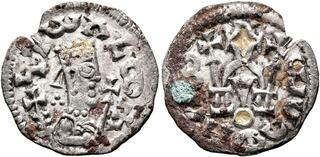| Leu Numismatik AG > Web Auction 28 | Auction date: 9 December 2023 |
| Lot number: 5556 Price realized: 150 CHF (Approx. 171 USD / 158 EUR) Note: Prices do not include buyer's fees. | Show similar lots on CoinArchives Find similar lots in upcoming auctions on |
| Lot description: Alla Amidas/Armeha, before 540-550s. Argyros (Gilt Billon, 18 mm, 1.03 g, 12 h). ነገሠአረመሐ ('ngsʼrmh' = 'King Armeha' in Ge'ez) Draped half-length bust of Alla Amidas/Armeha to right, wearing gilt tiara and circular earring, holding long cross-tipped scepter in his right hand and with bracelets on his right arm; to left, cross-tipped scepter decorated with barley ear and triangle consisting of three pellets. Rev. ሠሀለመሰለመ ('shlwslm' = 'Mercy and peace' in Ge'ez) Distyle arch surmounted by central cross in outline inlaid in gold flanked by two cross-tipped scepters, containing chalice (?) with round base inlaid in gold. Hahn, Aksumite, 71. Hahn & Keck, MAKS, 70. Munro-Hay, AC, type 151. Flan crack and with some deposits, otherwise, very fine. From the Dr. Stephan Coffman Collection. Armeha has previously been considered a contemporary of the prophet Muhammed, based on a story recorded by the Muslim historian, Muhammad ibn Jarīr al-Tabarī (circa 839-923), who mentions a prince Arha living in the 7th century. This moved his coinage to the very end to the Axumite series, and the lack of gold coins in his name would thus reflect the dire economic straits Axum found itself in by this time. Hahn & Keck (MAKS, p. 118), however, argue that Armeha is more likely to be a different name for Alla Amidas, a close successor of Kaleb, and thus his coins are considerably earlier. Both the silver and bronze coinage of Alla Amidas/Armeha were innovative. Firstly, it saw the permanent introduction of Ge'ez to these metals, which nearly completely supplanted Greek over the following decades. Moreover, the iconography of his silver issues is highly intriguing. Various interpretations have been offered for the curious design found on the reverse, ranging from a decorated throne to a triumphal arch or the Spring of Life, while the object in the middle has variously been described as a key, as the stone closing off the Holy Sepulchre, or as a crown. The latter in particular evokes the story of Kaleb donating his crown to the Church of the Holy Sepulchre in Jerusalem, but the shape does not seem to accord well with a crown. Hahn & Keck interpret the object as a chalice containing the blood of Christ (hence also the gilding of the base). The central gilded cross then represents Christ, while the cross-tipped scepters underline his status as King of Kings. All taken together, the scene symbolizes the Eucharist, in which the blood of Christ was transformed for the deliverance of all believers. Starting price: 50 CHF |  |



